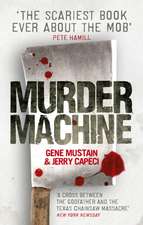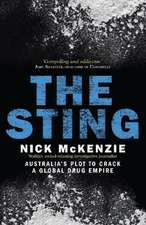Crime in a Psychological Context: From Career Criminals to Criminal Careers
Autor Glenn D. Waltersen Limba Engleză Paperback – 4 oct 2011
• examines the latent structure of crime-related constructs such as psychopathy, antisocial personality disorder, and criminal lifestyle
• explores evidence-based interventions that could prevent further crime
• offers a view of the phenomenological world of the criminal offender to help students further understand the nature of crime.
Preț: 556.08 lei
Preț vechi: 722.18 lei
-23% Nou
Puncte Express: 834
Preț estimativ în valută:
106.41€ • 111.47$ • 88.19£
106.41€ • 111.47$ • 88.19£
Carte tipărită la comandă
Livrare economică 08-22 aprilie
Preluare comenzi: 021 569.72.76
Specificații
ISBN-13: 9781412996082
ISBN-10: 1412996082
Pagini: 288
Ilustrații: Illustrations
Dimensiuni: 152 x 229 x 15 mm
Greutate: 0.38 kg
Ediția:New.
Editura: SAGE Publications
Colecția Sage Publications, Inc
Locul publicării:Thousand Oaks, United States
ISBN-10: 1412996082
Pagini: 288
Ilustrații: Illustrations
Dimensiuni: 152 x 229 x 15 mm
Greutate: 0.38 kg
Ediția:New.
Editura: SAGE Publications
Colecția Sage Publications, Inc
Locul publicării:Thousand Oaks, United States
Cuprins
1. Understanding Crime: The Prime Context
Predator
Crime
In Context
The Organization of this Book
Conclusion
Key Terms and Concepts
2. Latent Structure: The Criminal Lifestyle in a Dimensional Context
The Self Mutilator
What is Latent Structure?
The Taxometric Method
Identifying the Number of Dimensions
Behavioral Dimensions of a Criminal Lifestyle
Cognitive Dimensions of a Criminal Lifestyle
Why Should We Care About Latent Structure?
Conclusion
Key Terms and Concepts
3. Classification: The Criminal Lifestyle in a Diagnostic Context
Mr. Consistency
Diagnostic Functions
Essentials of Categorical Diagnosis
Essentials of Dimensional Diagnosis
Constructing a Dimensional Diagnosis for the Criminal Lifestyle
Analyzing Trends and Identifying Patterns
Conclusion
Key Terms and Concepts
4. Assessment: The Criminal Lifestyle in an Appraisal Context
Tuesday’s Child
Clinical Forensic Psychology
Construct Assessment
Risk Assessment
Broad-Band Clinical Forensic Assessment Instruments
Narrow-Band Clinical Forensic Assessment Instruments
Clinical Forensic Evaluation of Grace
Conclusion
Key Terms and Concepts
5. Development or Propensity: The Criminal Lifestyle in an Etiological Context
Born Under a Bad Sign
Development versus Propensity in Explaining Crime
A Lifestyle Theory of Crime
Jerry Revisited: A Developmental Analysis
Conclusion
Key Terms and Concepts
6: Phenomenology: The Criminal Lifestyle in a Subjective Context
Married to the Mob
Phenomenology
Responses to the Ten Questions
Conclusion
Key Terms and Concepts
7. Intervention: The Criminal Lifestyle in a Programmatic Context
The Boxer
Programmed Intervention
Unassisted Change
The “Nothing Works” Controversy
Finding a Philosophy
Implementing the Program
Evaluating the Outcome
Conclusion
Key Terms and Concepts
8. Prevention: The Criminal Lifestyle in a High Risk Youth Context
Dennis the Menace
Primary, Secondary, and Tertiary Prevention
The Lifestyle Approach to Secondary Prevention
Conclusion
Key Terms and Concepts
9. Mental Illness and Malingering: The Criminal Lifestyle in an Application Context
Tattoo
Mental Illness
Malingering
Conclusion
Key Terms and Concepts
10. Future Contexts and Distance Horizons
The Second Story Man
Understanding Crime: The Prime Context
Future Dimensional Contexts
Future Diagnostic Contexts
Future Appraisal Contexts
Future Etiological Contexts
Future Subjective Contexts
Future Programmatic Contexts
Future Preventive Contexts
Future Application Contexts
Conclusion
Key Terms and Concepts
Predator
Crime
In Context
The Organization of this Book
Conclusion
Key Terms and Concepts
2. Latent Structure: The Criminal Lifestyle in a Dimensional Context
The Self Mutilator
What is Latent Structure?
The Taxometric Method
Identifying the Number of Dimensions
Behavioral Dimensions of a Criminal Lifestyle
Cognitive Dimensions of a Criminal Lifestyle
Why Should We Care About Latent Structure?
Conclusion
Key Terms and Concepts
3. Classification: The Criminal Lifestyle in a Diagnostic Context
Mr. Consistency
Diagnostic Functions
Essentials of Categorical Diagnosis
Essentials of Dimensional Diagnosis
Constructing a Dimensional Diagnosis for the Criminal Lifestyle
Analyzing Trends and Identifying Patterns
Conclusion
Key Terms and Concepts
4. Assessment: The Criminal Lifestyle in an Appraisal Context
Tuesday’s Child
Clinical Forensic Psychology
Construct Assessment
Risk Assessment
Broad-Band Clinical Forensic Assessment Instruments
Narrow-Band Clinical Forensic Assessment Instruments
Clinical Forensic Evaluation of Grace
Conclusion
Key Terms and Concepts
5. Development or Propensity: The Criminal Lifestyle in an Etiological Context
Born Under a Bad Sign
Development versus Propensity in Explaining Crime
A Lifestyle Theory of Crime
Jerry Revisited: A Developmental Analysis
Conclusion
Key Terms and Concepts
6: Phenomenology: The Criminal Lifestyle in a Subjective Context
Married to the Mob
Phenomenology
Responses to the Ten Questions
Conclusion
Key Terms and Concepts
7. Intervention: The Criminal Lifestyle in a Programmatic Context
The Boxer
Programmed Intervention
Unassisted Change
The “Nothing Works” Controversy
Finding a Philosophy
Implementing the Program
Evaluating the Outcome
Conclusion
Key Terms and Concepts
8. Prevention: The Criminal Lifestyle in a High Risk Youth Context
Dennis the Menace
Primary, Secondary, and Tertiary Prevention
The Lifestyle Approach to Secondary Prevention
Conclusion
Key Terms and Concepts
9. Mental Illness and Malingering: The Criminal Lifestyle in an Application Context
Tattoo
Mental Illness
Malingering
Conclusion
Key Terms and Concepts
10. Future Contexts and Distance Horizons
The Second Story Man
Understanding Crime: The Prime Context
Future Dimensional Contexts
Future Diagnostic Contexts
Future Appraisal Contexts
Future Etiological Contexts
Future Subjective Contexts
Future Programmatic Contexts
Future Preventive Contexts
Future Application Contexts
Conclusion
Key Terms and Concepts
Notă biografică
Descriere
Referencing clinical case studies throughout, this engaging book encourages students to critically examine crime-related constructs such as psychopathy, antisocial personality disorder and criminal lifestyle, and to explore evidence-based interventions that could prevent further crime.














